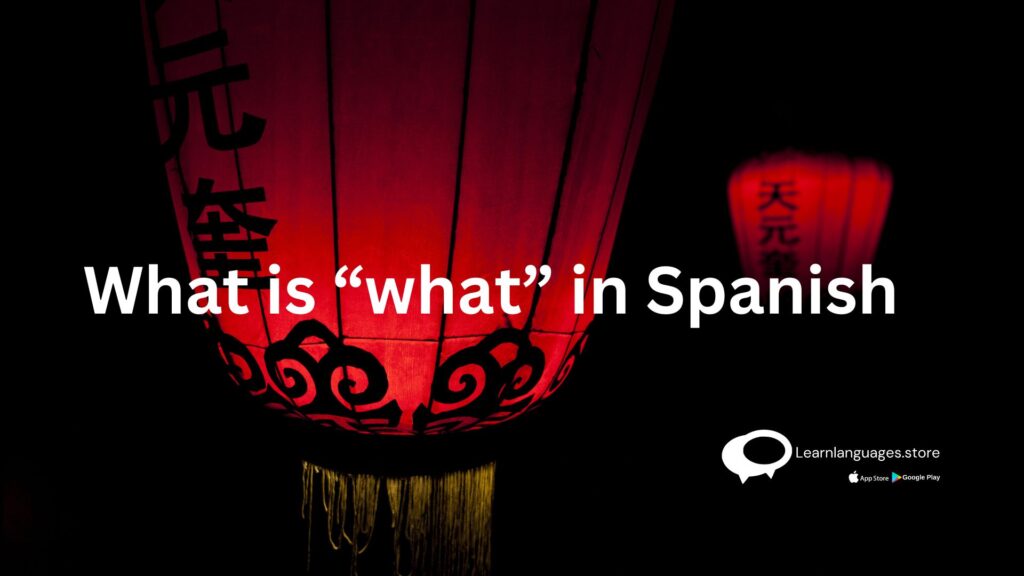5 words and phrases you can use to say ‘what’ in Spanish
5 words and phrases you can use to say ‘what’ in Spanish
For any learner, being able to express “what” in Spanish is a necessary ability. You can ask questions about things you don’t understand, satisfy your curiosity, and have some of the best conversations in Spanish by learning the words and phrases for “what.”
Estimated reading time: 7 minutes
This article will show you five alternative ways to inquire “what” in Spanish depending on the circumstance. In order to comprehend how these terms are used in everyday situations, we also advise you to look at the examples. then let’s get going!
What is “what” in Spanish

1. Qué (as a pronoun)
“What” is two different ways to translate the word qué: as a pronoun and as an adjective. When followed by a verb, qué acts as a pronoun. Qué, as an interrogative pronoun, will always have an accent mark regardless of its position in the sentence. However, it is usually found at the beginning:
¿Qué quiere comer tu novio?
(What does your boyfriend want to eat?)
¿Qué necesitas para preparar la pizza?
(What do you need to prepare the pizza?)
¿Qué has desayunado hoy?
(What have you eaten for breakfast today?)

Despite the fact that the previous three examples were all direct questions, this will not always be the case. In indirect questions, Qué can also be used as an interrogative pronoun. For example:
Necesito saber qué vas a comer.
(I need to know what you’re going to eat.)
Dime qué pediste en el restaurante.
(Tell me what you ordered at the restaurant.)
No sé qué puedo añadirle al batido.
2. Qué (as an adjective)
The second meaning of “what” in Spanish (qué) may appear to differ slightly from the first. In this case, qué serves as an adjective in the sentence. As a result, it will be followed by a noun rather than a verb.

If you don’t care about grammar and just want to learn conversational Spanish, you can ignore this fact and remember that “what” is usually translated as qué, but it’s always a good idea to know these little interesting facts about the language you are learning.
No matter what your situation is, remember that qué can also be followed by nouns:
¿Qué fruta es tu favorita?
(What’s your favorite fruit?)
¿Qué desayuno es ese?
(What kind of breakfast is that?)
¿Qué sopa es mejor para el dolor de estómago?
(What soup is the best for a stomachache?)
Adjectival qué can also appear in indirect questions and indirect speech:
Necesitamos saber qué fruta es tu favorita.
(We need to know what your favorite fruit is.)
Me preguntó qué desayuno era ese.
(She asked me what kind of breakfast it was.)
No sabía qué sopa era la mejor para el dolor de estómago.
(He didn’t know what the best soup for a stomachache was.)
The adjectival qué can also be used as an exclamatory adjective. Remember to use the opening exclamation mark (¡) before the closing one:
¡Qué alegría comer pizza!
(I’m so happy to eat pizza! [Lit.: What happiness to eat pizza!])
¡Qué cosas tan deliciosas cocinas!
(You cook such delicious food! [Lit.: What things so delicious you cook!])
¡Qué tomate más delicioso!
(What a delicious tomato! [Lit.: What tomato so delicious!])
Keep a close eye on these examples as they can help you learn to speak Spanish like native speakers.
3. Cómo
Cómo only means “what” in very specific contexts, so you need to pay attention now. Use cómo with the meaning of “what” to express your surprise and/or annoyance at what has occurred or what someone has said.

¡Cómo! ¡Eso no puede ser verdad! ¡Él no sabe cocinar! (What! That can’t be true! He doesn’t know how to cook!)
¿Cómo? ¡No me lo puedo creer! ¿Ana ha hecho el pastel? (What? I can’t believe it! Ana has baked the cake?)
In every other case, cómo will mean “how.” Let’s have a look at some examples:
¿Cómo se usan los palillos? (How are chopsticks used?)
¿Cómo cocinaste el pollo? (How did you cook the chicken?)
4. Lo que
When we translate lo que literally, it means “that which.” This, however, makes the English translation sound a little awkward:
Lo que m√°s me gusta es comer pasta.
(That which I like the most is eating pasta.)
No sé lo que vamos a almorzar.
(I don’t know that which we will have for lunch.)
Come lo que quieras.
(Eat that which you want.)
However, replacing “that which” for “what” in these sentences makes them sound much more natural. Take a look at this:
Lo que m√°s me gusta es comer pasta.
(What I like the most is eating pasta.)
No sé lo que vamos a almorzar.
(I don’t know what we’ll have for lunch.)
Come lo que quieras.
(Eat what you want.)
We can conclude from this that lo que is better translated as “what.” If you look at the examples again, you will notice that this que lacks an accent mark. It is critical that you remember this. Lo qué is a slang term for the interrogative pronoun qué, and it should be avoided like the plague.
5. Cu√°l
In Spanish, the final meaning of “what” is cuál, which is also an interrogative word that can be a pronoun or an adjective depending on whether it is followed by a verb or a noun.

When you have to choose between two or three options, use cuál. More than three can exist, but the number is usually small and limited/defined. Most of the time, you can replace “what” with “which” and the meaning remains the same:
¬øCu√°l vino prefieres?
(What wine [of the ones I’m showing you] do you prefer?)
¬øCu√°l pastel te gusta m√°s?
(What cake [of the ones you are eating] do you like the most?)
When the option is not limited to a few specific items, but to an entire category, choose qué. Here are a couple of examples to help you understand:
¿Qué vino prefieres?
(What wine [of all the wines in the wine category existing in the world] do you prefer?)
¿Qué pastel te gusta más?
(What cake [of all the cakes in the cake category existing in the world] do you like the most?)
Frequently asked questions

Q. What is the slang for what in Spanish?
A. The most common translation of “what” is qué.
Q. Does Porque mean what?
A. Porque means “because” in Spanish.
Q. Which ‘what’ word cannot be used in all situations?
A. Cómo only means “what” in very specific contexts, so you need to pay attention now. Use cómo with the meaning of “what” to express your surprise and/or annoyance at what has occurred or what someone has said.
Conclusion
In this guide, we have covered five different ways to say ‘what’ in Spanish along with the examples. Find similar examples, learn them and you will be asking great questions in Spanish in no time.
Learn Languages Store
Vashi,
Email: services@learnlanguages.store










